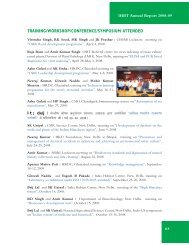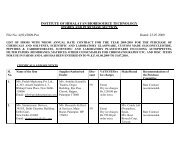Create successful ePaper yourself
Turn your PDF publications into a flip-book with our unique Google optimized e-Paper software.
CSIR-<strong>IHBT</strong> <strong>Annual</strong> <strong>Report</strong> 2010-11Headspace analysis of tea flowersTea flowers were analysed by headspace-GC/MS at different stages of development (unopened budto full bloom; I, II and III). The important insect attractants, cis-hex-3-ene-1-ol, acetophenoneand cis- furanoid linalool oxide were highest in stages I, II and III, respectively (Table 14).Table 14 Headspace analysis of volatiles in tea flowers at different stages of developmentCompound RRI RRI Bud Petals start to split Full bloom(HP-5) (BP-20) (stage I) (stage II) (stage III)2-Amyl furan 833 1241 nd nd 0.973-Hexen-1-ol 863 1393 3.46 2.83 2.12n-Hexyl formate 926 861 0.97 nd ndBenzaldehyde 966 1528 7.77 11.45 20.941-Octen-3-ol 973 1461 9.84 5.58 8.81(Z)-Furanoid linalool oxide 1062 1449 1.81 1.18 1.12Acetophenone 1064 1654 23.58 34.83 20.15Linalool 1078 1559 42.53 nd nd(E)-Furanoid linalool oxide 1101 1477 3.75 30.42 35.141-Phenylethanol 1109 1822 1.1 nd ndBenzyl alcohol 1140 1849 1.21 nd 1.41Methyl salicylate 1207 1775 1.57 1.18 1.9Nerol 1225 1807 0.31 0.26 ndGermacrene D 1490 1914 nd 0.51 0.52Octadecane 1788 1548 0.41 nd ndNonadecane 1903 1523 0.2 nd ndEicosane 2000 1528 nd 0.46 ndGINKGO (Ginkgo biloba)It is a medicinal plant known for blockage of platelet activating factor, free radical scavenging,neuritogenic and vasoprotective properties. Fifteen bioactive molecules comprising of ginkgolides,flavonoids, biflavonoids and steroidal glucoside were isolated from n-butanol fractions using animproved extraction method. In DPPH and ABTS assays, the n-butanol and ethyl acetate fractionsshowed antioxidant activities (Fig. 42). In another study, a simple, sensitive, selective and preciseRP-HPTLC method was developed and validated for the densitometric quantification of majorflavonoids and biflavonoids (Fig. 43).46




